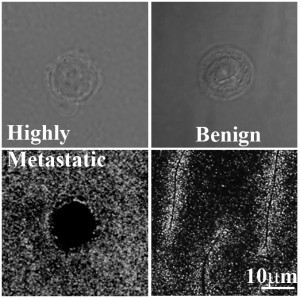Curbing the Metastases
This month is Breast Cancer Awareness Month in Israel and around the world. Innovative technology developed at the Technion Faculty of Biomedical Engineering will enable the prediction of cancer metastasis after the appearance of breast cancer. The technology, whose efficacy has been proven in preliminary laboratory-trials, is entering into advanced testing using cells from patients undergoing surgery.
Assistant Professor Daphne Weihs recently achieved a research breakthrough: the unique technology that she developed – a biomechanical method for early detection of metastatic cancer – was approved by the Ethics Committee. This means that the technology that was found to be effective in tests on cell lines will advance to trials with tumor cells collected directly after surgery, in cooperation with Rambam Healthcare Campus.
According to Assistant Professor Weihs, the practical concept is that “during or immediately after a biopsy or surgery on a malignant tumor, the system will enable the medical team to quantitatively evaluate the likelihood of the presence or development of tumor metastases in other organs, and to propose which organ or organs are involved. Such knowledge will make it possible to act at a very early stage to identify and curb these metastases and, moreover, to prevent the primary tumor from metastasizing further.
Cancer is a general name for a wide family of diseases – more than 200 – whose common denominator is that the cell division rate becomes uncontrolled and the cells become immortal. In other words, the cancer mechanism disrupts the normal cell division process and converts it into “wild” and rapid division. Since the cells do not age and do not die, the original, primary tumor expands, invades and takes over more and more nearby tissue. In addition, apart from spreading to its immediate vicinity, a tumor that has become very aggressive “knows” how to send metastases to more distant tissues through the lymph and circulatory systems. Metastases (secondary tumors) are usually more dangerous than the primary tumor because it is difficult to identify them at their inception. When they are detected at an advanced stage, treating them medically is more complicated and the medical prognosis is typically not good.
“In fact, most cancer-related deaths are caused by metastases rather than by the primary tumor, and therefore vast resources are invested in developing methods for early detection of metastases,” explains Assistant Professor Daphne Weihs. “Early detection means timely and more effective treatment. The new approach that we are developing will enable early prediction of the likelihood of the formation of metastases and where in the body their development is probable. This prediction is based on identifying the biomechanics of the primary tumor cells, and does not require us to know the specific genetic makeup of the tumor.”

In contrast to benign cells (right), metastatic cells (left) penetrate into the gel and disappear inside it, thanks to their unique characteristics
“Cancer cells have different characteristics from healthy cells, and they strive to penetrate and take over healthy tissue in order to increase the volume into which they can spread. To facilitate this, during their evolution (i.e. during the formation of mutations) cancer cells have developed structural flexibility; based on the characteristics of the healthy tissue, the cells change their own characteristics: shape, internal structure, rigidity and more. By adapting the forces that they apply to the nature of the healthy tissue that they encounter and interact with, they manage to penetrate it. It is interesting to note that the secret of cancer cells is not hardness but rather softness – cancer cells are softer and more flexible than healthy cells, and metastatic cells (cancer cells with the potential for metastasis) are even softer and more flexible. This softness enables the cells to make their way into dense tissue but, at the same time, these soft cells are also adaptable and know how to stiffen and apply considerable force on their environment when they want to penetrate it.
Assistant Professor Weihs has developed a unique process of three-dimensional biomechanical imaging, following a series of studies. “With this system we allow the cells being tested to ‘grip’ the designated gels that simulate the stiffness of healthy tissue. Monitoring the change in the shape of the cells, the internal arrangement inside them, and the forces that they exert on the gel enables us to reveal the differences between metastatic cells and benign cells and to identify the cells’ process of adaptation to changing environments in the body. This is a vital step to the prediction of metastases and their identification in the early stages that allow more effective treatment.”
As stated, following successful trials with the innovative diagnostic tool on human cell lines, the Ethics Committee has approved initial trials in humans. The trials are currently being carried out, in collaboration with Rambam Healthcare Campus. Up to now, the research has focused on breast cancer, and it is now expanding to pancreatic cancer and stomach cancer.
Assistant Professor Daphne Weihs, faculty member at the Faculty of Biomedical Engineering, earned three degrees at the Technion Faculty of Chemical Engineering. She then did her post-doc at the Department of Pathology at the David Geffen School of Medicine at UCLA. In her post-doc, which was financed by NASA because of its implications for biology and medicine in space conditions, she began to study her current subject: cell mechanics, with an emphasis on cancer cell behavior.
Assistant Professor Weihs is on the list of Israel’s 50 most influential women in 2015 recently published by the newspaper Lady Globes, thanks to her discoveries in the diagnosis of tumor metastasis, which represent a “breakthrough that will save lives in the future.”



